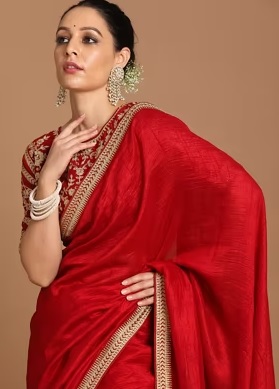All over the world women who love to wear saree have at least one silk saree in their wardrobe. This is a unique piece of smooth, glittering, soft cloth of different patterns and designs. These sarees are available in different border styles as different borders on both sides, with broad borders some with narrow frames, and some carrying no edge. The fashion brand Manyavar has a huge collection of royal sarees for the royal ladies to satisfy their fashion trends.
Origin of Silk
Silk is thought to have been invented and popularized in an Eastern state. Originally, it was only the domain of royalty and, later, the elite. During pre-industrial times, silk was one of the most essential international trade items. Silk and sericulture are mentioned in India’s Indus Valley Civilization and Harappa archaeological documents. Silk saree is thought to have entered the Western world via the renowned Silk Road from the Asian continent.
Adaptability of Silk Sarees
Silk’s adaptability is one of the main reasons for its popularity. Silk is a natural protein fabric with various varieties; therefore, there is plenty of textural variation.
Sarees are unstitched fabrics that are worn flat. No amount of sewing or cutting can add uniqueness. Variations in design, colour, material, and texture are thus crucial. Silk is one such yarn that excels at all of these aspects. Beautiful sarees are created by weaving cloth and intricate motifs from silk yarn. No other fabric can provide the same effect or weave pattern as silk.
Silk variation: wild silk
A common silk variation is wild silk. It is more difficult to obtain than commercially made silk yarn, yet it is valued for its exquisite texture. Tussar silk is a type of silk made from a non-mulberry source. Muga silk is another prominent type known for its strong golden-yellow silk yarn. Eri Silk, Anaphe Silk, Mussel Silk, Spider Silk, Coan Silk, and Fagara Silk are other non-mulberry varieties.
Silk varieties
Many silk varieties and blends have been developed to serve this purpose. Silk is combined with other fabrics to offer robustness and strength to Wedding Saris because they are adorned and decorative. The lavishly ornamented bridal sarees, decorated with hand embroideries like Zardousi, The aari, and Tilla, often have a silk or silky texture blend foundation.
Printed Silk Saris
While printed silk saree are highly popular and well received as formal, office-wear sarees and are worn regularly by business leaders, educators, and important celebrities/women, several other types of Silk Saris are an integral part of the occasional Sari and Ceremony Sari lists. In reality, silk is used to make the majority of popular and conventional marriage Sarees and Sarees for the brides.
Fusion in Silk
A fusion of numerous civilizations, foreign influences, and indigenous weaving/production processes has created incredible and one-of-a-kind saree artworks. It’s amazing how practically every region of the nation has its unique silk saree. Most of these are hand-woven, handloom sarees made of either pure silk fibre or silk fibre combined (with cotton yarn and Zari).
Conclusion
Silk is a prized fabric, and many weaving techniques and patterns have been used for centuries to create stunning silk sarees. Silks have also been associated with the Mughal and Persian influences on Asian culture. A silk saree is such an important part of any Indian woman’s life that mere words, documents, and sheets cannot express their splendour and magnificence. In modern days, the renowned brand Manyavar has a huge collection of royal silk sarees to give the ladies an elevated style.


